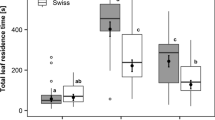Abstract
Mate-finding strategies and adaptations in pre- and postcopulatory behaviors to avoid male disturbance were studied in Crocothemis erythraea at two different sites. At ponds without perch sites males patrolled with temporal partitioning of the limited oviposition sites and male-male disputes were rare. The arrival rate of females was high. At temporary marshes with dense emergent vegetation the oviposition sites were widely distributed. Males mainly perched and interacted with longer disputes. At both types of habitats with high male densities females showed a similar number of copulations per visit and oviposition durations. Postcopulatory behavior to avoid male disturbance and to decrease remating of the female differed in both sexes. At the ponds with patrolling males the probability of remating in guarded and unguarded ovipositions was similar and higher than at the marshes. At the marshes 78% of rematings occurred when the guarding male was still involved in disputes with the previously disturbing male. At the ponds females hovered before escaping successfully from approaching males and they changed to another oviposition site where they continued oviposition. Females at the marshes remated after surprise attacks by neighboring males.
Similar content being viewed by others
References
Aguesse, P. (1959). Notes sur l'accouplement et la ponte deCrocothemis erythraea (Brullé)(Odonata: Libellulidae).Vie Milieu 10: 176–184.
Alcock, J. (1979). Multiple mating inCalopteryx maculata and the advantage of non-contact guarding by males.J. Nat. Hist. 13: 439–446.
Alcock, J. (1987). Male reproductive tactics in the Libellulid dragonflyPaltothemis lineatipes: temporal partitioning of territories.Behaviour 103: 157–173.
Alcock, J. (1989). The mating system ofBrechmorhoga pertinax (Hagen): The evolution of brief patrolling bouts in a “territorial” dragonfly (Odonata: Libellulidae).J. Insect Behav. 2: 49–62.
Campanella, P. J., and Wolf, L. L. (1974). Temporal leks as a mating system in a temperate zone dragonfly (Odonata: Anisoptera). I.Plathemis lydia (Drury).Behaviour 51: 49–87.
Convey, P. (1990). Influences of the choice between territorial and satellite behaviour in maleLibellula quadrimaculata Linn. (Odonata: Libellulidae).Behaviour 106: 125–141.
Emlen, S. T., and Oring, L. W. (1977). Ecology, sexual selection and the evolution of mating systems.Science 198: 215–223.
Falchetti, E., and Utzeri, C. (1974). Preliminary observations on the territorial behavior ofCrocothemis erythraea (Brullé) (Odonata, Libellulidae).Fragm. Entomol. 10: 295–300.
Harvey, I. F., and Hubbard, S. F. (1987). Observations on the reproductive behaviour ofOrthemis ferruginea (Fabricius) (Anisoptera: Libellulidae).Odonatologica 16: 1–8.
Heinrich, B., and Casey, T. H. (1978). Heat transfer in dragonflies: “Fliers” and “perchers.”J. Exp. Biol. 74: 17–36.
Jacobs, M. E. (1955). Studies on territorialism and sexual selection in dragonflies.Ecology 36: 566–586.
Kaiser, H. (1976). Raeumliche und zeitliche Aufteilung des Paarungsplatzes bei GroBlibellen (Odonata, Anisoptera).Verh. Ges. Ökol. Wien 1975: 115–120.
Kaiser, H., (1985). Availability of receptive females at the mating place and mating chances of males in the dragonflyAeschna cyanea.Behav. Ecol. Sociobiol. 18: 1–7.
Miller, P. L. (1982). Temporal partitioning and other aspects of reproductive behaviour in two African Libellulid dragonflies.Entomol. Month. Mag. 118: 177–188.
Moore, A. J. (1987). The behavioral ecology ofLibellula luctuosa (Burmeister) (Anisoptera. Libellulidae). I. Temporal changes in the population density and the effects on male territorial behavior.Ethology 75: 246–254.
Moore, A. J. (1989). The behavioral ecology ofLibellula luctuosa (Burmeister) (Odonata: Libellulidae). III. Male Density, OSR, and male and female mating behaviorEthology 80: 120–136.
Pajunen, V. I. (1963). Reproductive behaviour inLeucorrhinia dubia Vander Linden andL. rubicunda (L.) (Odonata: Libellulidae).Ann. Entomol. Fenn. 29: 106–118.
Pajunen, V. I. (1966). The influence of population density on the territorial behaviour ofLeucorrhinia rubicunda L. (Odon., Libellulidae).Ann. Zool. Fenn. 3: 40–52.
Parr, M. J. (1983). An analysis of territoriality in Libellulid dragonflies (Anisoptera: Libellulidae).Odonatologica 12: 39–57.
Rehfeldt, G. (1989a). Female arrival at the oviposition site inPlatycypha caligata (Selys): Temporal patterns and relation to male activity (Zygoptera: Chlorocyphidae).Adv. Odonatol. 4: 89–93.
Rehfeldt, G. (1989b). The influence of male interference on female perching behavior before and during oviposition in libellulid dragonflies (Anisoptera).Odonatologica 18: 365–372.
Sherman, K. J. (1983). The adaptive significance of postcopulatory mate guarding in a dragonfly,Pachydiplax longipennis.Anim. Behav. 31: 1107–1115.
Siva-Jothy, M. T. (1984). Sperm competition in the family Libellulidae (Anisoptera: Odonata) with special reference toCrocothemis erythraea (Brullé) andOrthetrum cancellatum (L.).Adv. Odonatol. 2: 195–207.
Siva-Jothy, M. T. (1988). Sperm “repositioning” inCrocothemis erythraea a libellulid dragonfly with a brief copulation.J. Insect Behav. 1: 235–245.
Thornhill, R., and Alcock, J. (1983).The Evolution of Insect Mating Systems, Harvard University Press, Cambridge, Mass.
Tsubaki, Y., and Ono, T. (1986). Competition for territorial sites and alternative mating tactics in the dragonfly,Nannophya pygmaea Rambur (Odonata: Libellulidae).Behaviour 97: 234–252.
Ubukata, H. (1984). Oviposition site selection and avoidance of additional mating by females of the dragonfly,Cordulia aenea amurensis Selys (Corduliidae).Res. Popul. Ecol. 26: 285–301.
Uéda, T. (1979). Plasticity of the reproductive behaviour in a dragonfly,Sympetrum parvulum Barteneff, with reference to the social relationship of males and the density of territories.Res. Popul. Ecol. 21: 135–152.
Waage, J. K. (1984). Sperm Competition and the evolution of odonate mating systems. In Smith, R. L. (ed.),Sperm Competition and the Evolution of Animal Mating Systems, Academic Press, New York, pp. 251–290.
Waage, J. K. (1986). Sperm displacement by two Libellulid dragonflies with disparate copulation durations (Anisoptera).Odonatologica 15: 373–392.
Waltz, E. C., and Wolf, L. L. (1984). By Jove! Why do alternative mating tactics assume so many different forms?Am. Zool. 24: 333–343.
Author information
Authors and Affiliations
Rights and permissions
About this article
Cite this article
Rehfeldt, G.E. Site-specific mate-finding strategies and oviposition behavior inCrocothemis erythraea (Brullé) (Odonata: Libellulidae). J Insect Behav 4, 293–303 (1991). https://doi.org/10.1007/BF01048279
Accepted:
Issue Date:
DOI: https://doi.org/10.1007/BF01048279




